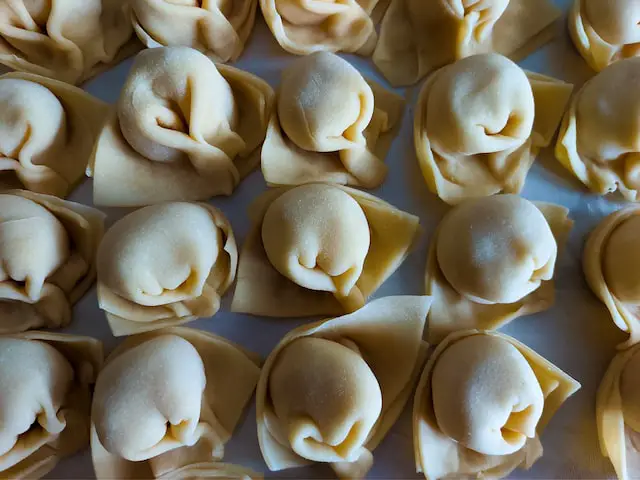Ravioli and tortellini are both delicious Italian pastas that can be enjoyed in many different ways. However, they have different shapes and fillings which makes them distinct from one another. Ravioli is usually a square-shaped pasta filled with cheese or vegetables while tortellini is typically circular with a minced meat filling. Both are sure to bring joy to any dinner table.
What is ravioli?
(Photo by davide ragusa on Unsplash )

Ravioli is a type of Italian pasta made of small square-shaped pockets of thin pasta dough that are filled with a variety of ingredients, such as cheese, meat, vegetables, or seafood. The pockets are typically sealed by pressing the edges of the pasta together, creating a small, compact package that is boiled or fried before serving. Ravioli is often served with tomato sauce, butter and sage, or other flavorful sauces. It is a popular dish in many parts of Italy, as well as in other countries around the world.
What is tortellini?
(Photo by Aknazar Arysbek on Unsplash )

Tortellini is a type of Italian pasta that is similar in shape to ravioli. It is made by rolling out small circles of pasta dough, which are then filled with a mixture of meat, cheese, or vegetables, and folded into a distinctive ring shape. Tortellini is traditionally served in a broth or with a cream-based sauce, and is often accompanied by grated Parmesan cheese. The origins of tortellini are disputed, but it is believed to have originated in the region of Emilia-Romagna in Northern Italy, where it is still a popular dish today.
The difference between ravioli and tortellini
Ravioli and tortellini are both types of Italian pasta that are similar in shape and filling, but they have some differences.
Shape: Ravioli are usually square-shaped or rectangular-shaped pockets of pasta dough, while tortellini are typically ring-shaped, with a small hole in the center.
Size: Ravioli are usually larger than tortellini, with each individual piece being around 2-3 inches in size. Tortellini are smaller, usually around 1 inch in diameter.
Filling: While both ravioli and tortellini can be filled with a variety of ingredients, tortellini are typically filled with meat-based fillings such as pork or beef, while ravioli may be filled with a broader range of ingredients such as cheese, vegetables, or seafood.
Region: Ravioli is a dish that is popular throughout Italy, while tortellini is particularly associated with the Emilia-Romagna region in Northern Italy.
Preparation: The preparation of ravioli and tortellini is similar, with both types of pasta being filled, folded, and then cooked by boiling or frying. However, the shape of tortellini requires more intricate folding and shaping, which can make it a bit more challenging to prepare than ravioli.
Overall, while ravioli and tortellini share many similarities, they have distinct differences in shape, size, filling, region, and preparation.
How to make ravioli?
To make ravioli, you need to make a pasta dough, roll it out into thin sheets, place dollops of filling on one sheet, cover with another sheet, press to seal around the filling, and cut into individual pieces.
Ravioli are usually larger than tortellini and have a thicker dough. The filling for ravioli can be meat-based, vegetable-based, or cheese-based, while the filling for tortellini is usually just cheese. Ravioli are typically served with a tomato-based sauce, while tortellini are typically served in a broth.
How to make tortellini?
To make tortellini at home, start by making the dough. Combine flour, water and eggs in a bowl and knead until a smooth dough forms. Then, roll out the dough as thin as possible. Cut out small circles of dough using a cookie cutter or knife. To make the rings, place a small amount of filling in the center of each circle and then carefully bring up the sides of the dough so that they meet in the middle. Pinch the dough together to seal in the filling.
Bring a pot of water to a boil and cook tortellini for 3-5 minutes until they float to the surface. Serve with your favorite sauce!
Is ravioli or tortellini healthier?
When it comes to health, ravioli and tortellini are fairly similar. Both are made with flour, water, and eggs, and both can be filled with a variety of different ingredients. However, there are a few key differences that may make one or the other slightly healthier for you.
For starters, ravioli is typically larger than tortellini. This means that there are more calories and carbohydrates in each ravioli than in each tortellini. If you’re watching your weight or trying to control your blood sugar levels, tortellini may be the better choice.
Another difference is in the way the two pasta shapes are traditionally served. Ravioli is often served with a sauce, while tortellini is typically served in broth. This means that ravioli can absorb more of the calories and fat from the sauce, making it less healthy than tortellini.
Overall, neither ravioli nor tortellini is particularly healthy or unhealthy – it really depends on what you fill them with and how they’re prepared. If you’re looking for a healthier option, try filling your ravioli or tortellini with vegetables or lean protein, and avoid serving them with high-fat sauces.
How do Italians eat ravioli?
Italians typically eat ravioli as a first course, followed by a second course of meat or fish. The ravioli are usually cooked in boiling water for a few minutes until they float to the surface. Once they are cooked, they are often served with a sauce, such as a tomato sauce, pesto sauce, or cream sauce.
Is tortellini pasta or dumpling?
If you’re wondering whether tortellini is a pasta or a dumpling, the answer is both! This pasta is made from flour and water, and can be filled with anything from cheese to meat. The dough is then rolled out into thin sheets, cut into small circles, and either left plain or filled.
Tortellini can be boiled like any other pasta, but it’s also commonly served in broth as a soup. And because the dough is so versatile, it can also be used to make Ravioli – another popular Italian dish!
What are the 4 types of pasta?
There are four main types of pasta: Spaghetti, Macaroni, Fusilli, and Penne. Each type of pasta has a unique shape and texture that makes it ideal for different dishes.
Spaghetti is the classic choice for Italian dishes like carbonara or Bolognese. Its long, thin shape means it can be served with light sauces or heavier meat-based sauces.
Macaroni is most commonly used in mac and cheese or baked dishes. Its short, tubular shape holds sauce well and gives a nice bite when cooked properly.
Fusilli is a good all-purpose pasta that can be used in everything from simple olive oil and garlic dishes to more complex ones with multiple ingredients. It’s also a good option for cold pasta salads.
Penne is another versatile pasta that can be used in a variety of dishes. Its wide tubes make it great for holding onto thick sauces, while its ridged surface helps grip lighter sauces.
What are the origins of ravioli and tortellini?
Ravioli and tortellini both have their origins in Italy. Ravioli is said to have originated in the city of Genoa, while tortellini is thought to have come from the city of Bologna. Both dishes are made with flour, water and eggs, and both can be filled with a variety of different fillings. The main difference between the two is that ravioli is typically square or rectangular in shape, while tortellini is usually circular.
Featured Image By – Photo by Aknazar Arysbek on Unsplash








